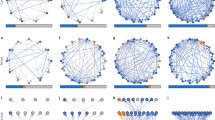Abstract
Dispersal within metacommunities can play a major role in species persistence by promoting asynchrony between communities. Understanding this role is crucial both for explaining species coexistence and managing landscapes that are increasingly fragmented by human activities. Here, we demonstrate that spatial patterning of dispersal connections can drastically alter both the tendency toward asynchrony and the effect of asynchrony on metacommunity dynamics commonly used to infer the potential for persistence. We also demonstrate that changes in dispersal connections in strictly homogeneous predator-prey metacommunities can generate an extremely rich variety of dynamics even when previously investigated properties of connectivity such as the magnitude and distribution of dispersal among patches are held constant. Furthermore, the dynamics we observe depend strongly on initial conditions. Our results illustrate the effectiveness of measures of spatial structure for predicting asynchrony and its effects on community dynamics, providing a deeper understanding of the relationship between spatial structure and species persistence in metacommunities.



Similar content being viewed by others
References
Anderson PW et al (1972) More is different. Science 177(4047):393–396
Arenas A, Díaz-Guilera A, Kurths J, Moreno Y, Zhou C (2008) Synchronization in complex networks. Phys Rep 469(3):93–153
Barahona M, Pecora LM (2002) Synchronization in small-world systems. Phys Rev Lett 89(5):054,101
Briggs CJ, Hoopes MF (2004) Stabilizing effects in spatial parasitoid–host and predator–prey models: a review. Theor Popul Biol 65(3):299–315
Brown JH, Kodric-Brown A (1977) Turnover rates in insular biogeography: effect of immigration on extinction. Ecology 58(2):445–449
Buckling A, Kassen R, Bell G, Rainey PB (2000) Disturbance and diversity in experimental microcosms. Nature 408(6815):961–964
Bunn AG, Urban DL, Keitt T (2000) Landscape connectivity: a conser- vation application of graph theory. J Environ Manag 59(4):265–278
Cahn JW, Hilliard JE (1958) Free energy of a nonuniform system. i. interfacial free energy. J Chem Phys 28(2):258–267
Chesson P, Huntly N (1997) The roles of harsh and fluctuating conditions in the dynamics of ecological communities. Am Nat 150(5):519–553
Crooks KR, Sanjayan M (2006) Connectivity conservation, vol 14. Cambridge University Press, Cambridge
Csardi G, Nepusz T (2006) The igraph software package for complex network research. InterJournal Complex Systems:1695. http://igraph.org
de Roos AM, McCauley E, Wilson WG (1998) Pattern formation and the spatial scale of interaction between predators and their prey. Theor Popul Biol 53(2):108–130
Gilarranz LJ, Bascompte J (2012) Spatial network structure and metapopulation persistence. J Theor Biol 297:11–16
Goldwyn EE, Hastings A (2008) When can dispersal synchronize populations Theor Popul Biol 73 (3):395–402
Gouhier TC, Guichard F, Gonzalez A (2010) Synchrony and stability of food webs in metacommunities. Am Nat 175(2):E16—E34
Hastings A (1993) Complex interactions between dispersal and dynamics: lessons from coupled logistic equations. Ecology 74(5):1362–1372
Hata S, Nakao H, Mikhailov AS (2014) Dispersal-induced destabilization of metapopulations and oscillatory turing patterns in ecological networks. Scientific reports 4
Holland MD, Hastings A (2008) Strong effect of dispersal network structure on ecological dynamics. Nature 456(7223):792–794
Holyoak M, Lawler SP (1996) Persistence of an extinction-prone predator-prey interaction through metapopulation dynamics. Ecology 77(6):1867–1879
Keith DA, Akċakaya HR, Thuiller W, Midgley GF, Pearson RG, Phillips SJ, Regan HM, Arau̇jo MB, Rebelo TG (2008) Predicting extinction risks under climate change: coupling stochastic population models with dynamic bioclimatic habitat models. Biol Lett 4(5):560–563
Koelle K, Vandermeer J (2005) Dispersal-induced desynchronization: from metapopulations to metacommunities. Ecol Lett 8(2):167–175
Leibold MA, Holyoak M, Mouquet N, Amarasekare P, Chase J, Hoopes M, Holt R, Shurin J, Law R, Tilman D et al (2004) The metacommunity concept: a framework for multi-scale community ecology. Ecol Lett 7(7):601–613
Liebhold A, Koenig WD, Bjørnstad ON (2004) Spatial synchrony in population dynamics. Annu Rev Ecol Evol Syst 35:467–490
Liu QX, Doelman A, Rottschȧfer V, de Jager M, Herman PM, Rietkerk M, van de Koppel J (2013) Phase separation explains a new class of self-organized spatial patterns in ecological systems. Proc Natl Acad Sci 110(29):11:905–11:910
Marleau JN, Guichard F, Loreau M (2014) Meta-ecosystem dynamics and functioning on finite spatial networks. Proc R Soc Lond B Biol Sci 281(1777):20132,094
Maser GL, Guichard F, McCann KS (2007) Weak trophic interactions and the balance of enriched metacommunities. J Theor Biol 247(2):337–345
Murdoch WW, Briggs CJ, Nisbet RM (2003) Consumer-resource dynamics, vol 36. Princeton University Press, Princeton
Paradis E, Baillie S, Sutherland W, Gregory R (1999) Dispersal and spatial scale affect synchrony in spatial population dynamics. Ecol Lett 2(2):114–120
Plitzko SJ, Drossel B (2015) The effect of dispersal between patches on the stability of large trophic food webs. Theor Ecol 8(2):233–244
Rosenzweig ML, MacArthur RH (1963) Graphical representation and stability conditions of predator-prey interactions. Am Nat 97(895):209–223
Saunders DA, Hobbs RJ, Margules CR (1991) Biological consequences of ecosystem fragmentation: a review. Conserv Biol 5(1):18–32
Soetaert K, Petzoldt T, Setzer RW (2010) Solving differential equations in r: Package desolve. J Stat Softw 33(9):1–25. https://doi.org/10.18637/jss.v033.i09. http://www.jstatsoft.org/v33/i09
Steiner CF, Stockwell RD, Kalaimani V, Aqel Z (2011) Dispersal promotes compensatory dynamics and stability in forced metacommunities. Am Nat 178(2):159–170
Stewart I, Golubitsky M, Pivato M (2003) Symmetry groupoids and patterns of synchrony in coupled cell networks. SIAM J Appl Dyn Syst 2(4):609–646
Swab RM, Regan HM, Keith DA, Regan TJ, Ooi MK (2012) Niche models tell half the story: spatial context and life-history traits influence species responses to global change. J Biogeogr 39(7):1266–1277
Taylor PD, Fahrig L, Henein K, Merriam G (1993) Connectivity is a vital element of landscape structure. Oikos 68(3):571–573
Turing AM (1952) The chemical basis of morphogenesis. Philos Trans R Soc Lond B Biol Sci 237(641):37–72
Watts DJ, Strogatz SH (1998) Collective dynamics of ‘small-world’networks. Nature 393(6684):440–442
Wolfrum M (2012) The turing bifurcation in network systems: Collective patterns and single differentiated nodes. Physica D: Nonlinear Phenomena 241(16):1351–1357
Yang L, Zhabotinsky AM, Epstein IR (2004) Stable squares and other oscillatory turing patterns in a reaction-diffusion model. Phys Rev Lett 92(19):198,303
Funding
K.E.A. was supported by National Science Foundation grant DEB-1553718 and a University of California Riverside Academic Senate Regents Faculty Development Award.
Author information
Authors and Affiliations
Corresponding author
Rights and permissions
About this article
Cite this article
Hayes, S.M., Anderson, K.E. Beyond connectivity: how the structure of dispersal influences metacommunity dynamics. Theor Ecol 11, 151–159 (2018). https://doi.org/10.1007/s12080-017-0355-y
Received:
Accepted:
Published:
Issue Date:
DOI: https://doi.org/10.1007/s12080-017-0355-y




